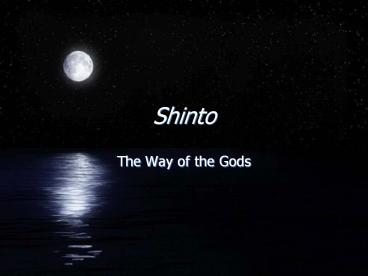Shinto - PowerPoint PPT Presentation
Title:
Shinto
Description:
Term coined in 8th century to distinguish Shinto from Buddhism. Shinto ... Kami dragon ... 9th century introduced the concept of representational images. ... – PowerPoint PPT presentation
Number of Views:124
Avg rating:3.0/5.0
Title: Shinto
1
Shinto
- The Way of the Gods
2
Shinto in History
- Ancient Religion
- Resurged during 15th century
3
Shen Do
- Shin Unfathomable Spiritual Power
- To tao way
- Also Way of the Gods
- Term coined in 8th century to distinguish Shinto
from Buddhism
4
Shinto
- Currently National Religion of Japan
- Historically, describes diverse religious
practices
5
Tenets
- Focus on adapting to life in this world.
- Focus on harmonious living with the natural
environment. - The dead are not less real than the living.
(p. 281)
6
Kami
- That which is particularly wondrous, whether in
nature or among people, they accepted as a
superior object of worship, called kami. - (Eastman, p. 260)
7
Kami includes
- Deities of earth and heaven
- Human beings, ghosts
- Birds, beasts, trees, plants, seas, mountains,
etc. - Anything awe-inspiring
- Good AND Evil
- Anything sacred or mysterious
8
Kami dragon
- Kami respond to human prayers and can influence
the course of natural fources and human events.
9
Shinto deities
- The arrival of Buddhism in Japan ca. 9th century
introduced the concept of representational
images. Often crafted to resemble male and
female aristocrats.
Seated Kami, 12th century
10
Shinto lacks
- Supporting body of philosophical and moral
literature.
11
Japanese Art
- Characterized by respect for nature.
- Combination of grace, grandeur and reverence for
subjects.
12
- Winter Landscape
- By Sesshu
- Ca. 1470s
13
- Bust of a Beautiful Lady Dressed in a Kimono
- Utamaro Kitagawa
- 1794
14
- The Great Wave off Kanagawa
- Hokusai Katsushika, ca. 1831
15
Noh Theatre
- Actors trained from childhood
- Stories from historical, literary sources (eg.
Ca. 1000 C.E.) - Reveals some working out of passions felt by a
character who often appears as a ghost - Main character usually masked
- Dance, pantomime, opera
16
Noh Theatre
- Tamura Dance of the Ghost
- Noh Theatre
- Highly stylized movement
- Slow, deliberate, gliding steps
- Long entrance to stage from House Left indicates
that it is a main hero or sidekick.
17
Traditional Noh Theater
18
Taiko in Noh
- Used ONLY in plays where the main character is a
god, demon, or some other nonhuman being.































